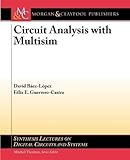Circuit analysis with multisim / David Báez-López and Félix E. Guerrero-Castro.
Material type: TextSeries: Synthesis lectures on digital circuits and systems: #35.Publisher: [San Rafael, Calif.] : Morgan & Claypool, ©2011Description: xiii, 182 pages : illustrations ; 24 cmContent type: text Media type: unmediated Carrier type: volumeISBN: 9781608457564; 1608457567Uniform titles: Synthesis digital library of engineering and computer science. Subject(s): Multisim | Electric circuits -- Computer simulation | Electric circuit analysis | Electronic circuits -- Computer simulation | Digital electronics -- Computer simulation | MultiSIM | Digital electronics -- Computer simulation | Electric circuit analysis | Electric circuits -- Computer simulation | Electronic circuits -- Computer simulationLOC classification: TK454 | .B34 2011
TextSeries: Synthesis lectures on digital circuits and systems: #35.Publisher: [San Rafael, Calif.] : Morgan & Claypool, ©2011Description: xiii, 182 pages : illustrations ; 24 cmContent type: text Media type: unmediated Carrier type: volumeISBN: 9781608457564; 1608457567Uniform titles: Synthesis digital library of engineering and computer science. Subject(s): Multisim | Electric circuits -- Computer simulation | Electric circuit analysis | Electronic circuits -- Computer simulation | Digital electronics -- Computer simulation | MultiSIM | Digital electronics -- Computer simulation | Electric circuit analysis | Electric circuits -- Computer simulation | Electronic circuits -- Computer simulationLOC classification: TK454 | .B34 2011| Item type | Current library | Call number | Copy number | Status | Notes | Date due | Barcode |
|---|---|---|---|---|---|---|---|
 Books
Books
|
Female Library | TK454 .B34 2011 (Browse shelf (Opens below)) | 1 | Available | STACKS | 51952000339274 | |
 Books
Books
|
Main Library | TK454 .B34 2011 (Browse shelf (Opens below)) | 1 | Available | STACKS | 51952000339281 |
Browsing Main Library shelves Close shelf browser

|

|

|

|

|

|

|
||
| TK 453 K26 MC1 Principles of electronic materials and devices / | TK454 .A452 2007 Fundamentals of electric circuits / | TK454 .A452 2009 Fundamentals of electric circuits / | TK454 .B34 2011 Circuit analysis with multisim / | TK454 .B368 1999 Basic electric circuit analysis / | TK454 .B44 2004 Computer simulated experiments for electric circuits using Electronics workbench multisim / | TK454 .B68 2010 Introductory circuit analysis / |
"This volume is a printed version of a work that appears in the Synthesis digital library of engineering and computer science"--Page 4 of cover.
Includes bibliographical references.
1. Introduction to circuit simulation -- 1.1 What is circuit simulation -- 1.2 What is multisim -- 1.3 Organization of the book -- Selected bibliography.
2. Resistive circuits -- 2.1 Circuit editing -- 2.1.1 Basic DC analysis -- 2.2 Multisim measurement instruments -- 2.2.1 Basic measurement instruments -- 2.2.2 The multimeter -- 2.2.3 The oscilloscope -- 2.2.4 The Wattmeter -- 2.2.5 The probe -- 2.3 Breadboard circuit capture -- 2.3.1 Three dimensional virtual components -- 2.4 Use of the multisim grapher -- 2.5 Circuits with controlled sources -- 2.5.1 Circuits with VCVS -- 2.5.2 Circuits with ICIS -- 2.5.3 Circuits with VCIS (G-source) -- 2.5.4 Circuits with ICVS (H-source) -- 2.6 Conclusions.
3. Time domain analysis, transient analysis -- 3.1 Capacitors and inductors -- 3.2 Input signal types -- 3.2.1 EXPONENTIAL signal -- 3.2.2 PULSE signal -- 3.2.3 PIECEWISE_LLINEAR signal (PWL) -- 3.2.4 Sinewave AC signal -- 3.2.5 Frequency modulated signal FM -- 3.2.6 Thermal noise signal -- 3.2.7 Amplitude modulated signal AM -- 3.3 Time domain analysis, transient analysis -- 3.3.1 Use of cursors -- 3.4 The oscilloscope and the distortion analyzer -- 3.4.1 The oscilloscope -- 3.4.2 The distortion analyzer -- 3.5 Fourier analysis -- 3.6 Additional examples -- 3.7 Conclusions.
4. Frequency domain analysis, AC analysis -- 4.1 AC analysis, frequency response -- 4.1.1 Loops with no resistance -- 4.2 Bode plots -- 4.3 Pole-zero analysis -- 4.4 Examples -- 4.5 Conclusions.
5. Semiconductor devices -- 5.1 Diodes -- 5.2 Transistors -- 5.3 Bipolar transistors -- 5.4 Junction field effect transistors-JFET's -- 5.5 Metal oxide semiconductor field effect transistors-MOSFET's -- 5.6 Additional examples -- 5.7 Conclusions -- Selected bibliography.
6. Digital circuits -- 6.1 Digital circuit components -- 6.2 Tools for digital circuit analysis -- 6.2.1 Logic analyzer -- 6.2.2 Word generator -- 6.2.3 Logic converter -- 6.3 Examples -- 6.4 Conclusions.
Authors' biographies.
This book is concerned with circuit simulation using National Instruments Multisim. It focuses on the use and comprehension of the working techniques for electrical and electronic circuit simulation. The first chapters are devoted to basic circuit analysis. It starts by describing in detail how to perform a DC analysis using only resistors and independent and controlled sources. Then, it introduces capacitors and inductors to make a transient analysis. In the case of transient analysis, it is possible to have an initial condition either in the capacitor voltage or in the inductor current, or both. Fourier analysis is discussed in the context of transient analysis. Next, we make a treatment of AC analysis to simulate the frequency response of a circuit. Then, we introduce diodes, transistors, and circuits composed by them and perform DC, transient, and AC analyses. The book ends with simulation of digital circuits.
1 2

There are no comments on this title.